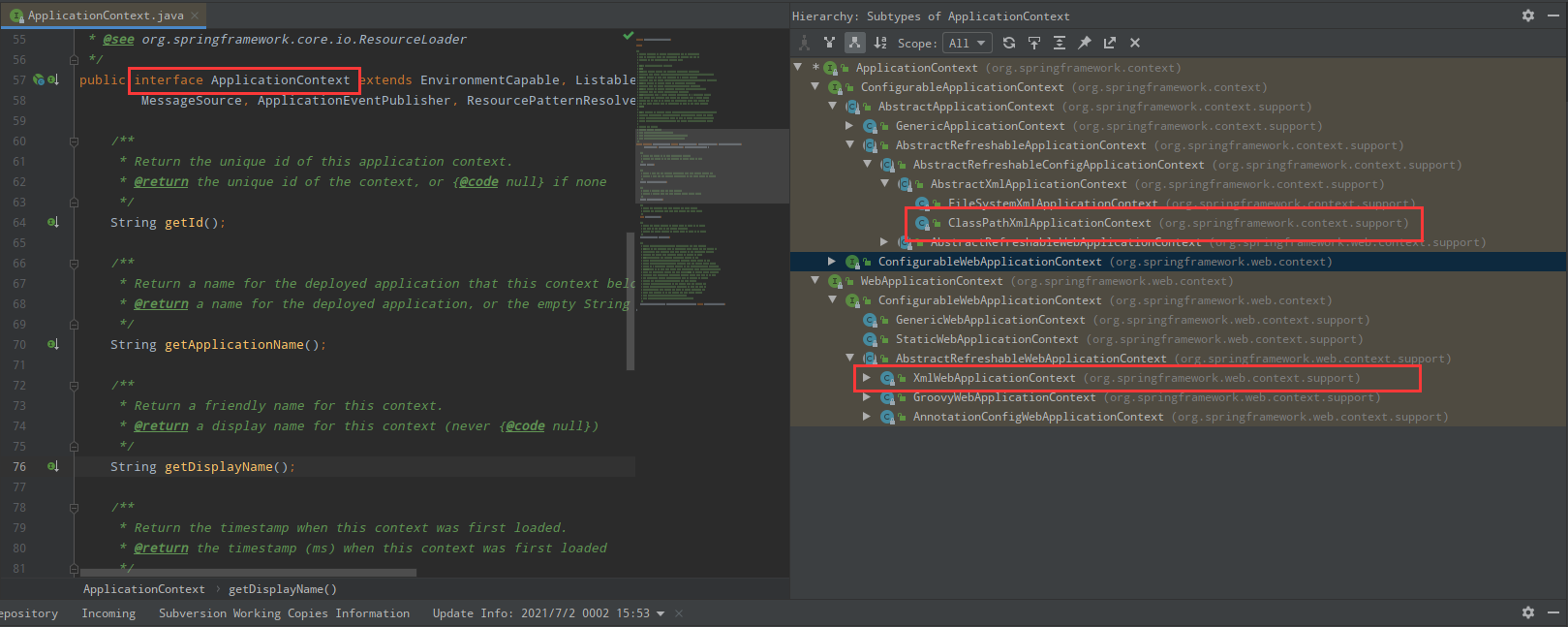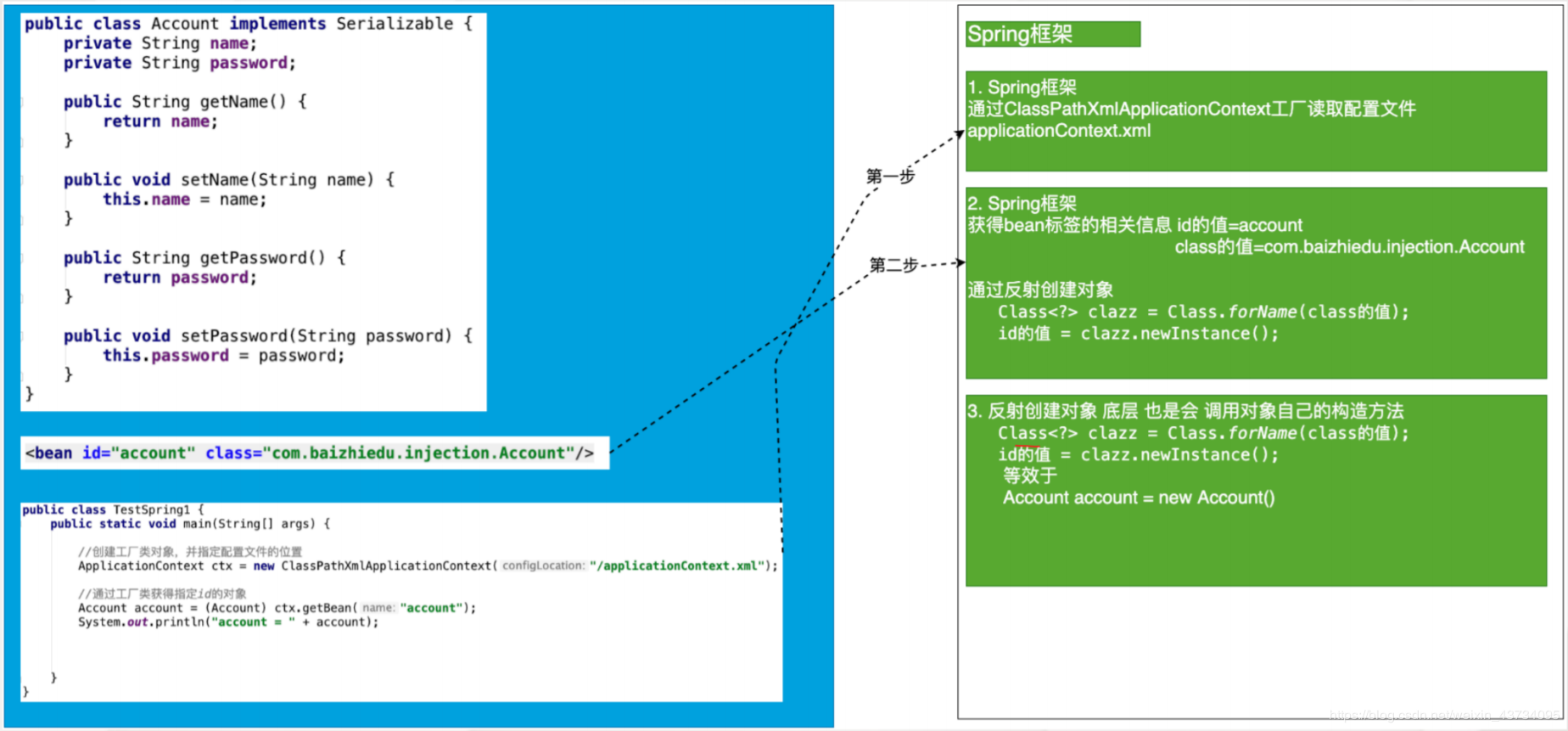1.软件版本
2.环境搭建
- ***设置 pom ***
<!--https://mvnrepository.com/artifact/org.springframework/spring-context -->
<dependency>
<groupId>org.springframework</groupId>
<artifactId>spring-context</artifactId>
<version>5.1.4.RELEASE</version>
</dependency>
- ***Spring的配置⽂件 ***
- 配置⽂件的放置位置:任意位置 没有硬性要求
- 配置⽂件的命名 :没有硬性要求 建议:applicationContext.xml
- ⽇后应⽤Spring框架时,需要进⾏配置⽂件路径的设置。

3.Spring的核⼼API
3.1 ApplicationContext
作⽤:Spring提供的ApplicationContext这个⼯⼚,⽤于对象的创建
好处:解耦合
3.2 ApplicationContext接⼝类型
接⼝:屏蔽实现的差异
⾮web环境(main函数、junit测试中):ClassPathXmlApplicationContext
web环境:XmlWebApplicationContext

3.3 ApplicationContext重量级资源
因为:ApplicationContext⼯⼚的对象(两个实现类)占⽤⼤量内存。
所以:不会频繁的创建对象 : ⼀个应⽤只会创建⼀个⼯⼚对象。
所以:ApplicationContext⼯⼚:⼀定是线程安全的(多线程并发访问)
4.程序开发
前面一节已经讲了,现在来回顾下:
- 创建类型
public class Person {}
- 配置⽂件的配置
applicationContext.xml中配置如下:
<?xml version="1.0" encoding="UTF-8"?>
<beans xmlns="http://www.springframework.org/schema/beans"
xmlns:xsi="http://www.w3.org/2001/XMLSchema-instance"
xsi:schemaLocation="http://www.springframework.org/schema/beans http://www.springframework.org/schema/beans/spring-beans.xsd">
<!--
id属性就是取名字
class属性配置全路径名
-->
<bean id="person" class="com.bearjun.basic.Person"/>
</beans>
- 通过⼯⼚类,获得对象
ApplicationContext的实现类ClassPathXmlApplicationContext来获取配置文件
/**
* 用于测试Spring的第一个程序
*/
@Test
public void test() {
// 1、获取spring的工厂
ApplicationContext ctx = new ClassPathXmlApplicationContext("/applicationContext.xml");
// 2、通过工厂类获得对象
Person person = (Person)ctx.getBean("person");
System.out.println(person);
}
5.细节分析
5.1 名词解释
名词解释:Spring⼯⼚创建的对象,叫做bean或者组件(componet);
所以,以后不管叫bean,或者是叫组件,都是由spring工厂创建的对象。
5.2 Spring⼯⼚的相关的⽅法
- getBean
传入 id值 和 类名 获取对象,不需要强制类型转换。
// 通过这种⽅式获得对象,就不需要强制类型转换
Person person = ctx.getBean("person", Person.class);
System.out.println("person = " + person);
- getBean
只指定类名,Spring 的配置文件中只能有一个 bean 是这个类型。
// 使用这种方式的话, 当前Spring的配置文件中 只能有一个bean class是Person类型
Person person = ctx.getBean(Person.class);
System.out.println("person = " + person);
- getBeanDefinitionNames
获取 Spring 配置文件中所有的 bean 标签的 id 值。
// 获取的是Spring工厂配置文件中所有bean标签的id值 person person1
String[] beanDefinitionNames = ctx.getBeanDefinitionNames();
for (String beanDefinitionName : beanDefinitionNames) {
System.out.println("beanDefinitionName = " + beanDefinitionName);
}
- getBeanNamesForType
根据类型获得 Spring 配置文件中对应的 id 值。
// 根据类型获得Spring配置文件中对应的id值
String[] beanNamesForType = ctx.getBeanNamesForType(Person.class);
for (String id : beanNamesForType) {
System.out.println("id = " + id);
}
- containsBeanDefinition
用于判断是否存在指定 id 值的 bean,不能判断 name 值。
// 用于判断是否存在指定id值的bean,不能判断name值
if (ctx.containsBeanDefinition("person")) {
System.out.println(true);
} else {
System.out.println(false);
}
- containsBean
用于判断是否存在指定 id 值的 bean,也可以判断 name 值。
// 用于判断是否存在指定id值的bean,也可以判断name值
if (ctx.containsBean("p")) {
System.out.println(true);
} else {
System.out.println(false);
}
5.3 配置⽂件中需要注意的细节
1、如果bean只配置class属性?会生成id嘛?
<bean class="com.bearjun.basic.Person"/>
会自动生成一个id
全路径命名#数字,例如com.bearjun.basic.Person#1
可以使用 getBeanNamesForType 验证。
应⽤场景:
如果这个bean只需要使⽤⼀次,那么就可以省略id值;
如果这个bean会使⽤多次,或者被其他bean引⽤则需要设置id值;
2、name属性:
作⽤:⽤于在Spring的配置⽂件中,为bean对象定义别名(取小名)
<bean id="person" name="p" class="com.bearjun.basic.Person"/>
Person person = (Person)ctx.getBean("p");
System.out.println("person = " + person);
相同点:
ctx.getBean("id")或ctx.getBean("name")都可以创建bean对象;<bean id="person" class="Person"/>与<bean name="person" class="Person"/>等效;
区别:
- 别名可以定义多个(name后面跟多个别名,用‘,’隔开),但是 id 属性只能有⼀个值;
- XML(spring的配置文件)的id属性的值,命名要求:必须以字⺟开头,后面跟上字⺟、数字、下划线、连字符;不能以特殊字符开头 /person开头不允许;
XML的name属性的值,命名没有要求,/person 可以。name属性会应用到特殊的命名场景下。
但其实XML发展到了今天:ID属性的限制已经不存在,/person也可以。 getBean与getBeanDefinitionNames获取bean的区别。
6.Spring⼯⼚的底层实现原理(简易版)
Spring⼯⼚是可以调⽤对象私有的构造⽅法创建对象

- classPathXmlApplicationContext工厂读去配置文件application.xml
- 通过id获取类的权限类名
- 反射获取类的对象
7.思考?
问题:在未来的开发过程中,是不是所有的对象都交给Spring工厂来创建那
回答:理论上是的。但是有特例:实体对象(entity)是不会交给spring创建的,它是由持久层框架进行创建的。




评论区